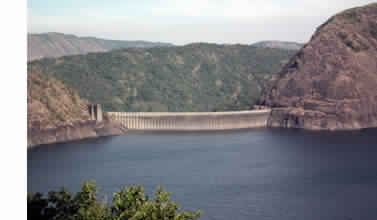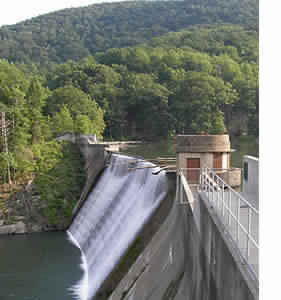Brief infomation about various types of Dams
A dam A dam is a barrier that stops or restricts the flow of water or underground streams. A dam can also be used to collect water or for storage of water which can be evenly distributed between locations. Dams generally serve the primary purpose of retaining water. Reservoirs created by dams not only suppress floods but also provide water for activities such as irrigation, human consumption, industrial use, aquaculture, and navigability. Hydropower is often used in conjunction with dams to generate electricity. A dam can also be used to collect water or for storage of water which can be evenly distributed between locations. Dams generally serve the primary purpose of retaining water, while other structures such as floodgates or levees (also known as dikes) are used to manage or prevent water flow into specific land regions.
Classification of Dam, according to use Storage dam Diversion dam Detention Dam According to hydraulic design Non overflow Overflow dam By materials Rigid dam Gravity dam Arch dam Buttress dam Steel dam Earth dam Non rigid dam Earth dam Rock fill dam.
- Types of dam :
- Arch dams Pond : An arch dam is curved in an arch-shape, with the top of the arch pointing back into the water, to create a very strong structural form, resistant to the water pressure behind the dam. Arch dams are usually made from concrete and require a good rock support for foundations and the sides, so are commonly used in narrow, steep-sided valleys.
- Buttress dams : Buttress dams have triangular-shaped walls, or buttresses, which are spaced at intervals on the downstream side, resisting water pressure against the upstream side. They must be constructed on sound rock and are typically made of concrete or masonry. Because of the spacing between the buttresses they can be quite efficient in terms of materials.
- Earth dams:
- Rock fill dams:
- A rockfill dam is a type of embankment dam which comprises primarily compacted rock materials. Shaped much like a bank or hill, rockfill dams are effective because the force of the river or reservoir hits the core of the embankment, is exerted in a downward direction, and transferred to the solid foundation of the dam.
- Gravity dams:
- A gravity dam is a dam constructed from concrete or stone masonry and designed to hold back water by primarily utilizing the weight of the material alone to resist the horizontal pressure of water pushing against it. Gravity dams provide some advantages over embankment dams.
- Steel dams:
- A steel dam is a type of dam (a structure to impound or retard the flow of water) that is made of steel, rather than the more common masonry, earthworks, concrete or timber construction materials..

Idukki dam is in Kerala, India, currently has the largest arch dam in Asia, and 555 meters. The dam is located on the two mountains - Kuravanmala (839 meters) and Kurathimala (925 feet). E 'was built and is owned by Kerala State Electricity Board.
 An embankment dam is a large artificial dam. It is typically created by the placement and compaction of a complex semi-plastic mound of various compositions of soil, sand, clay, or rock. It has a semi-pervious waterproof natural covering for its surface and a dense, impervious core.
An embankment dam is a large artificial dam. It is typically created by the placement and compaction of a complex semi-plastic mound of various compositions of soil, sand, clay, or rock. It has a semi-pervious waterproof natural covering for its surface and a dense, impervious core.







